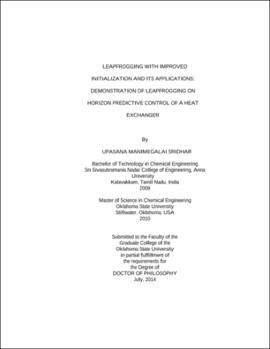| dc.contributor.advisor | Rhinehart, R. Russell | |
| dc.contributor.author | Sridhar, Upasana Manimegalai | |
| dc.date.accessioned | 2015-06-17T20:06:51Z | |
| dc.date.available | 2015-06-17T20:06:51Z | |
| dc.date.issued | 2014-07 | |
| dc.identifier.uri | https://hdl.handle.net/11244/14984 | |
| dc.description.abstract | Leapfrogging (LF) is a recently developed optimization technique that initially places players in random spots in the feasible decision variable space [1]. The approach to reach the global optimum is by "Leaping" the player with the worst objective function (OF) value "Over" the player with the best OF value into the reflected hyper volume that connects the player with the best and the worst OF until the players converge at an optimum [1]. LF has several advantages compared to other optimization techniques in terms of computational efficiency and higher probability to reach the global optimum [1]. This is demonstrated in several applications [1-7]. | |
| dc.description.abstract | The main focus of this work is to develop LF [8] by exploring the initialization step through a fundamental analysis and supporting the developed technique with mathematical truths. In this improvisation the OF surface is initially explored with a large number of players, the players are sorted in ascending order of their OF values and the top few players are selected to continue with the optimization technique. This improvement is found to increase the probability of finding the global optimum as one of the initial players is placed in the vicinity of the global optimum during initialization and thus draws all the other players towards it. | |
| dc.description.abstract | In order to establish the applicability of LF and its improvement on process engineering applications, this work focusses on implementation of original and modified LF to model a pilot scale Shell and Tube Heat Exchanger (HX 001) process, which is nonlinear. Steam is used to increase the temperature of the water on the cold side. For this study, the outlet temperature of the cold side fluid is considered as the control variable (CV). The hot side steam valve opening is considered as the manipulated variable (MV). This CV-MV relation is modeled using original and modified LF to find the model parameters that best fit the experimental skyline function generated for modeling purpose in the Unit Operations Lab, OSU-Stillwater. Next, the model parameters are used to implement a horizon predictive control on the HX001 process to control the CV. | |
| dc.format | application/pdf | |
| dc.language | en_US | |
| dc.rights | Copyright is held by the author who has granted the Oklahoma State University Library the non-exclusive right to share this material in its institutional repository. Contact Digital Library Services at lib-dls@okstate.edu or 405-744-9161 for the permission policy on the use, reproduction or distribution of this material. | |
| dc.title | Leapfrogging with improved initialization and its applications: Demonstration of leapfrogging on horizon predictive control of a heat exchanger | |
| dc.contributor.committeeMember | Johannes, Arland H. | |
| dc.contributor.committeeMember | Bell, Kenneth J. | |
| dc.contributor.committeeMember | Whiteley, James R. | |
| dc.contributor.committeeMember | Vennavelli, Anand N. | |
| osu.filename | Sridhar_okstate_0664D_13448.pdf | |
| osu.accesstype | Open Access | |
| dc.type.genre | Dissertation | |
| dc.type.material | Text | |
| dc.subject.keywords | direct search | |
| dc.subject.keywords | horizon predictive control | |
| dc.subject.keywords | leapfrogging | |
| dc.subject.keywords | optimization | |
| dc.subject.keywords | regression modeling | |
| dc.subject.keywords | surface exploration | |
| thesis.degree.discipline | Chemical Engineering | |
| thesis.degree.grantor | Oklahoma State University | |
